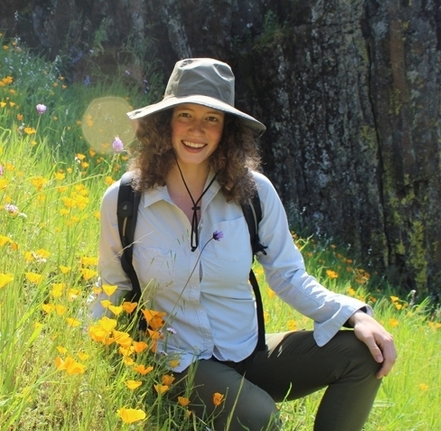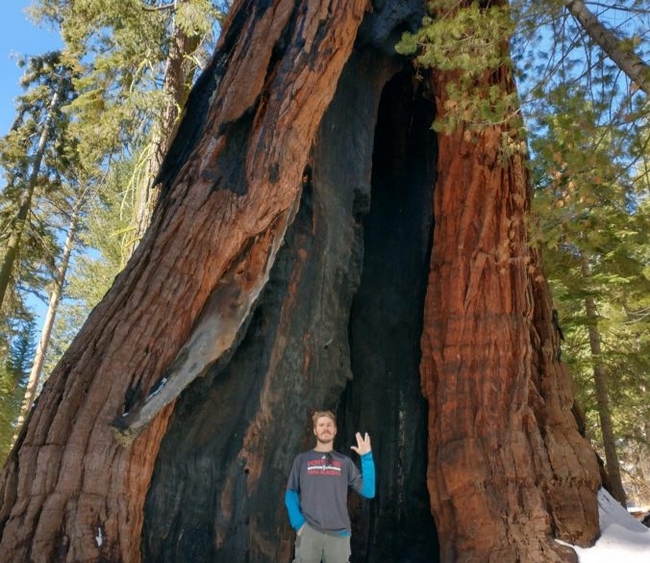Twelve graduate students with the UC Davis Department of Entomology and Nematology--and one affiliated with the department--will discuss their research in student competitions at the Entomological Society of America meeting in Denver, to be held Oct. 31-Nov. 3 in the Colorado Convention Center.
A total of 10 entomology graduate students will deliver presentations in the 10-minute oral student competitions, and two will present posters. The events are scheduled Monday, Nov. 1.
10-Minute Student Speech Competitions:
- Jill Oberski, doctoral candidate who studies with major professor Phil Ward
Category: Systematics, Evolution and Biodiversity: Phylogenetics and Phylogenomics
Title: "Arid-Adapted Pyramid Aants (Formicidae: Dorymyrmex) Show an Amphitropical Distribution and an Ongoing Radiation."
- Zachary Griebenow, doctoral candidate who studies with major professor Phil Ward
Category: Systematics, Evolution and Biodiversity: Parasites and Symbionts
Title: "Discovery of a Putative Troglomorphic Ant (Hymenoptera: Formicidae: Leptanillinae)"
- Lacie Newton, doctoral candidate who studies with major professor Jason Bond
Category: Systematics, Evolution and Biodiversity: Phylogentics and Phylogenomics
Title: "Establishing a Robust Combined-Evidence Phylogeny of the Trapdoor Spider Genus Aptostichus (Araneae: Mygalomorphae: Euctenizidae)"
- Lindsey Mack, PhD student who studies with major professor Geoffrey Attardo
Category: Medical, Urban and Veterinary Entomology: Mosquitoes, Biting Midges and Flies
Title: "Gene Expression Temporal Analysis of Pyrethroid Response in Californian Aedes aegypti"
- Danielle Rutkowski, PhD student who studies with major professor Rachel Vannette
Category: Plant-Insect Ecosystems: Ecology 3
Title: "Fungicide Impacts on Bumble Bees are Mediated via Effects on Bee-Associated Fungi"
- Maureen Page, doctoral candidate who studies with major professor Neal Williams
Category: Plant-Insect Ecosystems: Pollinators
Title: "Optimizing Pollinator-friendly Plant Mixes to Simultaneously Support Wild and Managed Bees"
- Xavier Zahnle, PhD student who studies with major professor Jason Bond
Category: Systematics, Evolution and Biodiversity: Evolution
Title: "Deep Homology Influences Llocalized Postembryonic Metamorphosis in Male Genitalia of the Flat-Backed Millipede Pseudopolydesmus serratus (Myriapoda, Diplopoda,Polydesmida,Polydesmidae)"
- Erin T. Kelly, doctoral candidate who studies with major professor Geoffrey Attardo
Category: Physiology, Biochemistry and Toxicology: Molecular Biology, Cellular Biology and Biochemistry
Title: "Using Metabolomic Analysis to Generate Insights into Pyrethroid Metabolism and Resistance in California Aedes aegypti"
- Jasmin Ramirez Bonilla, master's student who studies with major professor Ian Grettenberger
Category: Plant and Insect Ecosystems: Field Crops 3
Title: "Stripes and spots: Evaluating an Aggregation Pheromone, vittatalactone, for Western Striped (Acalymma trivittatum) and Western Spotted (Diabrotica undecimpunctata undecimpunctata) Cucumber Beetles"
- Madison Hendrick, PhD student who studies with major professor Ian Gettenberger
Category: Plant and Insect Ecosystems: Field Crops 1
Title: "Clarifying Pyrethroid Resistance and Exploring Interactions with Insecticide Use in California Alfalfa Weevil"
Posters:
- Mia Lippey, PhD student who studies with major professors Jay Rosenheim and Emily Meineke
Poster in the Plant-Insect Ecosystems Section, Behavior and Ecology: "Effects of Surrounding Landscapes on the Fork-tailed Bush Katydid (Scudderia furcata) in California Citrus"
- Gabriel "Gabe" Foote, PhD student who initially studied with (the late) Steve Seybold and is now advised by Hugh Safford Region 5 Regional Ecologist/Affiliate Faculty (UC Davis).
Poster in Plant-Insect Ecosystems Section, Pollinators, "Landscape and Stand Level Factors Affecting Wild Bee Diversity in the Californian Central Sierra Nevada"
Abstracts:
Speech Competition
Jill Oberski
Dorymyrmex Mayr 1866, the “pyramid ants” or “cone ants,” are conspicuous inhabitants of arid landscapes across the Americas, found primarily in the temperate regions north and south of the tropics. Despite being frequently collected and ecologically important, they exemplify the taxonomic neglect typical in the subfamily Dolichoderinae. By targeting ultraconserved elements (UCEs) across the genome, I have constructed an alignment of 1891 genetic loci and inferred phylogenies using a variety of methods. The three major clades of Dorymyrmex that arise correspond both to previous, morphologically defined conceptions of the genus and to geographical distribution. One clade in particular, the pyramicus group, is enormously widespread but shows minimal morphological differentiation—a major reason that the genus has been neglected by traditional taxonomy. I characterize this radiation, explore methods that may help increase its resolution, and ponder what species delimitation in this group may entail. Finally, I present my observations on biogeography: a general south-to-north dispersal pattern, with an intercontinental transition that occurred between the Miocene and Pleistocene, i.e., when North and South America were not connected, a pattern seen in other arid-adapted amphitropical New World taxa. Characterizing these groups and the difficulty of this largely Nearctic radiation is an important first step in resolving the taxonomic puzzle of Dorymyrmex ants, which have garnered attention from many angles, including behavior, chemical ecology, and physiology.
Zachary Griebenow
Despite their diversity and ubiquity across terrestrial ecosystems, the ants (Formicidae) are rare in cave environments. At present, only two described ant species are regarded as exhibiting a cave-adapted phenotype, i.e., troglomorphism. Here, we report workers of an undescribed species of Yavnella (Leptanillinae: Leptanillini) collected from the milieu souterrain superficiel (MSS) near salt caves in Fars Province, Iran. The body and appendages of this ant are bizarrely elongated, precluding the soil-dwelling behavior observed in other leptanilline ants. Therefore, this Yavnella sp. is confined to preexisting cavities and is troglomorphic, making it one of a very few examples of this syndrome among the ants. This species is recovered within Yavnella, aclade so far known only from males,by maximum-likelihood phylogenomic inference from ultra-conserved elements (UCEs). This conclusion corroborates the utility ofmulti-locus data for associating disparate forms in polymorphic organisms such as ants. (Co-authors of this paper are Majid Moradmand of the University of Isahan, Iran; Marco Isaia, University of Turin, Italy)
Xavier J. Zahnle
In the arthropod subphylum Myriapoda, localized modification of walking legs is taxonomically widespread. Male millipedes (class Diplopoda) exemplify this phenomenon, with diverse postembryonic walking leg transformations including clasping organs, reduced or hyper-enlarged leg pairs, and intromittent copulatory genitalia called gonopods. Gonopods are fully formed in adult males, but usually develop internally through several stadia.
The clear developmental continuity throughout the transformation of walking legs into gonopods invites comparison between the two types of appendages. We hypothesized that, using a criterion of topology, muscles of the gonopods could be identified as serial homologs of those in the walking legs. µCT x-ray imaging was used to illustrate the appendicular skeletal elements and muscles of the flat-backed millipede Pseudopolydesmus serratus.
Special attention was paid to the origin and insertion points of muscles as potential points of topological continuity preserved through development. Additionally, a series of juvenile male Pseudopolydesmus stadia was imaged using µCT to investigate the structural transformation of the future gonopod appendage pair. Topological continuity of muscles between walking legs and gonopods could be established for only a few muscles. Moreover, the developmental series revealed near-complete obliteration of appendicular muscles before adult gonopod formation begins, disproving the hypothesis that gonopod muscles are physically retained serialhomologs of those in the walking legs. Therefore, the few structural similarities between muscles in walking legs and gonopods are more likely due to the structure being preserved from the ancestral node of gonopod-bearing millipedes (deep homology) than to developmental continuity within the individual. (Co-authors of paper are Professor Jason Bond and Megan Ma.)
Lacie Newton
The trapdoor spider genus
Aptostichus comprises forty-one species, most of which are primarily restricted to the California Floristic Province, a known biodiversity hotspot; however, four species inhabit Nevada, Arizona, and Oaxaca, Mexico.
Aptostichus range widely in size and coloration as well as occupy a variety of habitats ranging from arid deserts to coastal dunes to high elevation alpine habitat. Additionally,
Aptostichus has a relatively high amount of species diversity when compared to other euctenizid genera and the majority of other mygalomorph groups. High species diversity and inhabiting a diversity of habitats underscore the pattern of an adaptive radiation in the genus, making them ideal organisms for investigating speciation pattern and process, character evolution, and adaptation. A previous study by Bond (2012) constructed a morphology-only phylogeny of the genus with uncertainty for several interspecific relationships. Building on this previous morphological work, we increased taxon sampling to include a recently described species (41 total) and used a sequence capture method (i.e.,ultra conserved elements) to generate genomic-scale data. We were successful in sequencing UCEs from historical ethanol-preserved museum specimens; thus, we were able to include rare and presumed extinct
Aptostichus species in both molecular and morphological datasets. From our datasets we established a robust ‘combined-evidence' phylogeny to provide a framework for exploring evolutionary phenomena. Specifically, we evaluate diversification rates within the genus, the evolution of characters associated with different habitat types (i.e., coastal dunes and desert), and how the patterns of diversification were potentially affected by geological events and ecological differences. (Paper is co-authored by James Starrett and Professor Jason Bond)
Lindsey Mack
Aedes aegypti, the vector of Zika and dengue, established in California in 2013 and have spread to 22 counties across the state. These mosquitoes arrived with resistance to pyrethroids, the primary class of insecticides used for public health applications. Pyrethroids act on the insect voltage gated sodium channels causing prolonged depolarization and death. Resistance is developed through mutations at the target site or over-expression of detoxifying enzymes like cytochrome P450s and glutathione-S-transferases (GSTs), however over 100 genes code for P450s in mosquitoes. To identify putative resistance mediating enzymes as well as the overall genetic response to insecticide exposure, mosquitoes were exposed to permethrin for 1 hour, then placed in a cage and collected 6, 10, and 24 hours post exposure for Tag-seq. The analysis identified 20 cytochrome P450s and 6 GSTs with significant increases in expression. Enzymes associated with oxidation-reduction reactions were overrepresented across time points suggesting the response results in significant oxidative stress. Another significant feature revealed upregulation of enzymes required for fundamental metabolic activities including glycolysis, the pentose phosphate shunt, and lipid metabolism. Overall, these findings reveal that these mosquitoes have a strong genetic response to insecticide exposure. In addition, this response appears to require activation of other fundamental metabolic pathways to reduce the associated oxidative stress and maintain the demand for energy generated by these activities. These results provide evidence of metabolic resistance in this population, new enzymatic targets for investigation, and new questions to pursue as to the resistance profile of these invasive Californian populations.Gene expression temporal analysis of pyrethroid response in Californian
Aedes aegypti. (Paper co-authored by Geoffey Attardo)
Danielle Rutkowski
Native bees including bumble bees are important pollinators but face threats from multiple sources, including agrochemical application. Declining bumble bee populations have been linked to fungicide application, which could directly affect the fungi often found in the stored food and GI tract of healthy bumble bees. Here, we test the hypothesis that fungicides impact bee health by disrupting bumble bee -fungi interactions. Using two species, Bombus vosnesenskii and B. impatiens, we test the interactive effect of the fungicide propiconazole and fungal supplementation on the survival, reproduction, and microbiome composition of microcolonies (queenless colonies). We found that both bee species benefitted from fungi, but were differentially affected by fungicides. In B. vosnesenskii, fungicide exposure decreased survival while fungal supplementation mitigated fungicide effects. For B. impatiens, fungicide application had no effect, but fungal supplementation improved survival and offspring production. Fungicides altered fungal microbiome composition in both species, and reduced fungal abundance in B. vosnesenskii microcolonies, but not in B. impatiens, where instead fungal addition actually decreased fungal abundance. Our results highlight species-specific differences in both response to fungicides and the nature of fungal associations with bees, and caution the use of results obtained using one species to predict the responses of other species. These results suggest that fungicides can alter bee- fungi interactions with consequences for bee survival and reproduction, and suggest that exploring the mechanisms of such interactions, including interactions within bee-associated fungal communities, may offer insights into bumble bee biology and bumble bee conservation strategies. (Paper co-authors are associate professor Rachel Vannette, Eliza Litsey and Isabelle Maalouf)
Maureen Page
Despite the recognized utility of wildflower plantings to support honey bees and wild bees these two goals have largely been pursued separately. Furthermore, pollinator-friendly plant mixes are currently selected using estimates of flower visitation without considering among-plant differences in nutritional quality or how competition among bees might affect plant use. The nutritional composition of pollen and nectar strongly affects bee health and survival and bees use nutritional information to make plant foraging decisions. Additionally, honey bees, which are generally stocked at high densities in crop lands, have been shown to compete with native pollinators for pollen and nectar resources and such competition may lead to changes in plant choice and narrowing of diet breadth. In this study, I use data on flower visitation patterns and the nutritional quality of nectar and pollen from different plant species in conjunction with recently developed optimization models to identify plant mixes that meet the goals of enhancing honey bee nutrition and maximizing support of diverse bee communities while minimizing competition. (Paper co-authored by Professor Neal Williams)
Erin T. Kelly
Resistance to pyrethroid based insecticides has facilitated the rapid spread of
Aedes aegypti mosquitoes throughout California.
Aedes aegypti demonstrate both metabolic and target site resistance mechanisms to insecticides, but precise mechanisms of pyrethroid detoxification are not yet well described and appear to vary between and within populations. For our study, we produced F2 generation colonies representing two genetically distinct populations of
Aedes aegypti from the San Joaquin Valley and from Southern California. These two populations were then subjected to a modified CDC bottle-assay with Deltamethrin, a pyrethroid insecticide. Following Deltamethrin exposure, we observed knock-down times and collected samples from the upper and lower knock-down quartiles, representing susceptible and resistant insects. We apportioned 10 pools of 5 adult female
Aedes aegypti organized by population and susceptible or resistant and submitted them to the West Coast Metabolomics center for high-throughput metabolomic analysis. This technique offers a snapshot of the insects' metabolomes, revealing different levels of activity and demands on metabolic pathways. We analyzed the data in MetaboAnalyst to look for differences between the susceptible and resistant insects and shared features between the two study populations. These analyses revealed that the susceptible individuals from both populations had higher levels of biomarkers associated with oxidative stress. Further research could shed new light on how invasive California
Aedes aegypti are detoxifying pyrethroids and ultimately allow for the discovery of better targeted vector control that exploits the mosquitoes' metabolic vulnerabilities (Paper is co-authored by assistant professor Geoffrey Attardo)
Jasmin Ramirez Bonilla
The western striped cucumber beetle,
Acalymma trivittatum, and western spotted cucumber beetle,
Diabrotica undecimpunctata undecimpunctata, are key pests of fresh market melons in northern CA. While both species are of concern the most detrimental species is the western striped cucumber beetle due to its affinity for smooth melon varieties such as honeydews and cantaloupes. The adults and the larvae feed on the fruit rind, creating scars and rendering the fruit unmarketable. Current management is mostly limited to intensive foliar applications of broad-spectrum insecticides. Although growers scout the fields, they do not possess effective monitoring strategies. Fortunately, an aggregation pheromone has been identified (vittatalactone) and synthesized for an eastern species, the striped cucumber beetle (
Acalymma vittatum). In this study, we examined and evaluated the attractiveness of vittatalactone to western cucumber beetles for two consecutive years (2020-2021). This field experiment was replicated across two organic sites in the Sacramento Valley, CA. Both trials consisted of deploying clear sticky traps that were either baited with vittatalactone or unbaited. In addition, we tested the effect of a commercial floral lure combined with the aggregation pheromone (2020) and the floral lure alone in a factorial design in 2021. We found that beetle captures are highly dependent on the growth stage of the crop (i.e., seedling, vegetative, or fruit). The highest captures appeared to be at the end of the season when the crop was harvested. These findings contribute to the future of vittatalactone as a useful monitoring tool and as an attract-and-kill approach. (Paper is co-authored by Donald Weber, Amber Vinchesi-Vahl and Ian Grettenberger)
Madison Hendrick
The alfalfa weevil (Hypera postica) is the primary pest of alfalfa across the Western United States. However, weevils in California are not easily controlled using biological, cultural, or other methods of control. Ultimately, weevil management is limited to chemical control, and there are relatively few Modes of Action (MoAs) registered for alfalfa weevil in California. The lack of chemical options further limits control options for this pest and increases risks of resistance development. Unfortunately, due to the limitations of both options and application cost, pyrethroid resistance is already an issue in some regions. As part of an ongoing project, in 2020 and 2021 we performed bioassay to assess resistance in alfalfa weevil populations across California. The assays were conducted by coating the inside of glass vials with the most-used pyrethroid, lambda-cyhalothrin, and placing weevils inside to expose them. The dose-response assays produced LC50s, which were used to quantify the level of resistance in each population. These results include data from susceptible regions, regions with known or suspected resistance, and potentially new area of concern. Additionally, the LC50s have been linked with the California Department of Pesticide Regulation pesticide use reports to find the relationship between history of pesticide use and resistance using a preliminary model. This project will address current resistance issues and help growers make science-based, proactive management decisions that will prolong the efficacy of current control options. Resistance management and monitoring in alfalfa may also translate to use in other cropping systems. (Paper is co-authored by Kevin Wanner and Ian Grettenberger)
Abstracts:
Posters
Mia UppeyGlobally, humans are introducing large expanses of crop plants into natural areas, such that agricultural landscapes are now patchworks of resources with which native herbivores have no prior experience. When novel crop host plants are introduced, the cues that once signaled a high-quality host may no longer be reliable, and adult insects may oviposit on host plants that are actually unsuitable for the development of their offspring. These anthropogenic “habitat traps'' can thus attract pest populations that rely on immigration from surrounding habitats to persist. In such cases, identifying putative source plants in the surrounding landscape is critical for pest management. Here, we examine how surrounding land use affects abundances of the fork-tailed bush katydid, a key pest of California citrus. Though katydids feed heavily on introduced citrus, they survive poorly when raised on citrus alone. Therefore, we predict that host plants in surrounding landscapes contribute to the persistence of katydids in citrus groves. California citrus groves are situated in a wide array of land uses, including myriad non-citrus crops, citrus groves of diverse cultivars, developed urban and suburban land, rangeland, and more natural areas. To improve katydid management, we used an ecoinformatics approach to determine which of these surrounding landscape types support the population buildup of katydids. Our results suggest that specific land use types surrounding citrus groves mediate the buildup of a damaging pest."
Gabriel Foote Flower-visiting insects provide essential pollination services to herbaceous plant communities in temperate coniferous forests, thereby helping to maintain food webs and support the overall functional diversity of these systems. To guide conservation efforts for forest-associated populations in western North America, ecologists have investigated the effects of both natural (drought, insect outbreaks, wildfire) and anthropogenic (forestry operations) disturbances on local insect pollinator abundance and diversity. However, studies comparing their community responses to the different types of forest disturbance (i.e.,abiotic versus biotic or anthropogenic) that have co-occurred within an individual forest landscape are few. To address this knowledge gap, we sampled the insect pollinator community during the summer of 2020 in undisturbed forest stands, combined with neighboring stands that underwent recent (post-2015) disturbance (drought, tree harvest, wildfire) located in mid-montane forest landscapes of the Californian central Sierra Nevada. In short, disturbed stands had a higher diversity of pollinators compared to neighboring, undisturbed stands. However, the magnitude of these differences varied by both disturbance type and severity. Overall, these results indicate that allowing for certain disturbances (e.g., moderate severity wildfires) that reduce shrub cover, expose bare ground surfaces and promote herbaceous plant growth on the forest floor may be optimal mechanisms for land managers to passively create beneficial habitat for insect pollinators in thisecoregion.
Kyle Lewald, College of Biological Sciences and Member of the Joanna Chiu Lab
Kyle Lewald, a doctoral student researcher affiliated with the College of Biological Sciences, and a member of the lab of molecular geneticist and physiologist Joanna Chiu, professor and vice chair of the UC Davis Department of Entomology and Nematology will compete in the category, Systems, Evolution and Biodiversity: Genetics and Molecular Biology. A member of the Integrated Genomics and Genetics Graduate Group, Lewald will discuss his research, "Assembly of Highly Continguous Diploid Genome for the Agricultural Pest, Tuta absoluta."
Tuta absoluta represents one of the largest threats to tomato production worldwide. While initially contained to South America throughout the 20th century, T. absoluta were detected in Spain in 2006 before rapidly spreading throughout Europe and Asia over the next decade. To facilitate study of pesticide resistance, adaptation, and control strategies, researchers require a high quality, highly contiguous, and well-annotated genome assembly. The currently published genome assembly was generated using short-read technology for the purpose of developing molecular markers and studying population genetics; however, due to the genome's large size, heterozygosity, and repetitiveness, the assembly was highly fragmented, making it unsuitable for annotation or functional genomic studies. To address this, we extracted DNA from a single T. absoluta individual for sequencing with long-read PacBio HiFi technology to avoid assembly issues expected due to high genetic diversity and repetitiveness. We have now successfully created a diploid assembly that contains 98% of complete BUSCO groups and 99% of initial raw reads, with an N50 of 6Mb. The genome is 3% heterozygous, and is 60% composed of repeat elements, explaining the fragmented nature of the previous assemblies. By annotating this assembly with previously published RNAseq, protein, and repeat-element datasets, we expect this resource to advance efforts in understanding and developing control strategies for this invasive moth. (Co-author is Joanna Chiu)
The 7000-member Entomological Society of America, founded in 1889 and headquartered in Annapolis, Md.,, is the world's largest organization serving the professional and scientific needs of entomologists and others in
</d

















